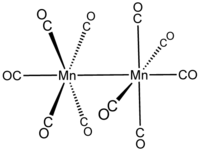
Photo from wikipedia
ConspectusNoncovalent interactions (NCIs) have long interested a vast community of chemists who investigated their "canonical categories" derived from descriptive crystallography, e.g., H-bonds, π-π interactions, halogen/chalcogen/tetrel bonds, cation-π and C-H-π interactions,… Click to show full abstract
ConspectusNoncovalent interactions (NCIs) have long interested a vast community of chemists who investigated their "canonical categories" derived from descriptive crystallography, e.g., H-bonds, π-π interactions, halogen/chalcogen/tetrel bonds, cation-π and C-H-π interactions, metallophilic interactions in the broad sense, etc. Recent developments in theoretical chemistry have enabled the treatment of noncovalent interactions under new auspices: dispersion-force-inclusive density functionals have emerged, which are reliable for modeling small to large molecular systems. It is possible to perform the full analysis of the contributions of London, Debye, and Keesom forces, i.e., the main components of van der Waals forces, by the DFT-D and ab initio methods at a reasonable computational cost. Our research has been focusing for now 15 years on the role of NCIs in the cohesion of organometallic complexes. NCIs are not only effective in Werner's secondary coordination sphere but also in the metal's primary one. The stabilization of electron-unsaturated transition metal complexes by hemichelation, metal-metal donor-acceptor complexes, and self-aggregation of cationic Rh(I) chromophores have indeed outlined the significance of the London dispersion force as an attractive force operating throughout the whole molecule or molecular assembly. The recent outburst of interest in C-H bond functionalization led us to address the broader question of reaction and catalyst engineering: although one can now satisfactorily analyze bonding and molecular cohesion in transition-metal-based organometallic systems, can modern theoretical methods guide reactivity exploration and the engineering of novel catalytic systems? We addressed this question by investigating the ambiphilic metal-ligand activation/concerted metalation-deprotonation mechanism involved in transition-metal-catalyzed directed C-H bond functionalization. This endeavor was initiated having in scope the construction of a rationale for the transposition of 4-5d metal chemistry to earth-abundant 3d metals. In this base-assisted mechanism of C-H bond metalation, agostic interactions are necessary but not sufficient because C-H bond breaking actually relies on the attractive NCI coding of a proton-transfer step and the minimization of metal-H repulsion. This Account introduces the recent shift of our research toward the construction of an NCI-inclusive paradigm of chemical reactivity engineering based on experimental efforts propped up by state-of-the-art theoretical tools.
Journal Title: Accounts of chemical research
Year Published: 2021
Link to full text (if available)
Share on Social Media: Sign Up to like & get
recommendations!